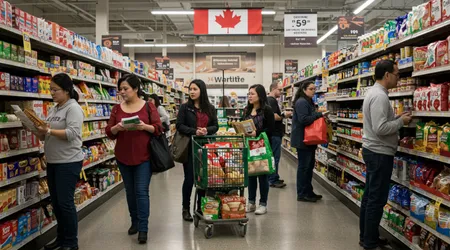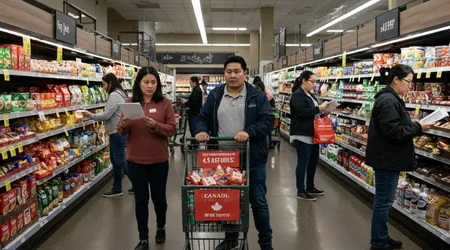Canadian Grocery Shoppers Shift Habits to Counter US Tariffs

Canadian grocery shoppers shift habits as US tariffs reshape the economic landscape, sparking a surge in national pride and a deliberate pivot to local products.
In 2025, grocery aisles reflect a quiet rebellion maple leaf tags signal Canadian-made goods, while shoppers bypass pricier American imports.
This shift, fueled by trade tensions and patriotic fervor, isn’t just about economics; it’s a cultural statement.
From small grocers to major chains like Sobeys, the push for domestic brands is reshaping consumer behavior.
Why are Canadians so determined to redefine their grocery carts?
This article explores the forces driving this change, its ripple effects, and what it means for the future.
The Catalyst: US Tariffs and Canadian Resolve
The Canadian grocery shoppers shift habits began with President Trump’s 25% tariffs on Canadian goods, announced in April 2025.
These levies hit exports like steel and autos, but grocery aisles felt the sting too. Canadian counter-tariffs on US imports, like oranges and coffee, raised prices, prompting shoppers to rethink choices.
Small grocers, unable to pivot supply chains quickly, face higher costs, while consumers dodge tariffed items.
A Business Insider report noted some stores labeling US goods with a “T” for tariffs, guiding buyers to alternatives.
This economic chess game has turned grocery shopping into a patriotic act.
Beyond tariffs, Trump’s rhetoric calling Canada the “51st state” ignited a cultural backlash.
Shoppers like Emily Burton, a Toronto teacher, now avoid American brands like Tropicana. “It’s personal,” she says, echoing a sentiment driving demand for Canadian orange juice.
Major retailers report a 68% spike in local product sales, per the Canadian Grocers Association. This isn’t just about saving money; it’s about identity.
The Canadian grocery shoppers shift habits reflects a nation asserting sovereignty through everyday choices.
++ Korean Coffee Chain Expands in Metro Vancouver
The ripple effects are profound. Small businesses, already strained, struggle to source affordable local goods.
Meanwhile, consumers embrace new recipes, like maple-glazed salmon over American BBQ ribs. This adaptability showcases resilience but highlights challenges for retailers lagging in supply chain shifts.
The Canadian grocery shoppers shift habits is a dynamic response to a trade war, blending economics with emotion.

A Surge in National Pride
Patriotism is reshaping grocery carts as Canadian grocery shoppers shift habits to favor homegrown brands.
A Spring Financial survey found 80% of Canadians prioritize local products, spurred by Trump’s annexation jibes.
Sobeys and Metro now highlight Canadian goods with prominent displays, boosting sales of brands like President’s Choice.
Shoppers like Vancouver’s Amit Patel swap Kellogg’s for Canadian oats, citing pride over price. This trend fosters unity, with communities rallying around local producers.
The Canadian grocery shoppers shift habits is less about cost, more about collective memory.
Consider the analogy of a hockey team defending its rink. Just as fans cheer louder when the game gets tough, Canadians shop local to protect their economic turf.
Small grocers, though, face hurdles perishable US produce, like tariffed avocados, spikes in price, squeezing margins.
Also read: Advance Voting Hits Record High, May Signal Increased Election Turnout
Yet, the “buy Canadian” mantra grows louder. Gary Sands of the Canadian Federation of Independent Grocers calls it unprecedented in 25 years.
The Canadian grocery shoppers shift habits is a cultural flex, not just a transaction.
This pride extends beyond groceries. Pubs ditch American bourbon for Canadian rye, and shoppers experiment with local cheeses over Kraft.
The movement’s strength lies in its grassroots momentum families share recipes, neighbors swap tips on Canadian brands.
But for every success, like thriving local dairies, there’s a small retailer grappling with supply chain delays. The Canadian grocery shoppers shift habits is a balancing act of heart and hustle.
Economic Impacts and Retail Strategies
The Canadian grocery shoppers shift habits carries hefty economic weight.
Loblaw, Canada’s retail giant, warned of price hikes on tariffed goods like coffee, citing “stacking tariffs” from Vietnam and the US.
Small grocers, reliant on US produce, see immediate cost jumps fresh produce tariffs hit hardest due to perishability.
CBC News reported moderated impacts on grocery budgets, as many US food items remain untariffed.
Still, the shift to local sources strains smaller players, who lack the buying power of chains like Real Canadian Superstore.
| Item | Pre-Tariff Price (CAD) | Post-Tariff Price (CAD) | Source |
|---|---|---|---|
| US Oranges (kg) | 3.99 | 5.49 | CBC News, 2025 |
| Canadian Oats (kg) | 2.49 | 2.49 (unchanged) | Sobeys, 2025 |
| US Coffee (500g) | 8.99 | 11.99 | Loblaw, 2025 |
Retailers adapt creatively. Your Independent Grocers uses maple leaf badges to mark Canadian products, easing shopper decisions.
Metro promotes online campaigns for local brands, predicting a 15% drop in US product sales by 2026.
For example, Halifax’s Corner Market now stocks Nova Scotia apples over California ones, delighting customers.
Yet, supply chain pivots aren’t seamless smaller stores struggle to secure Turkish oranges.
The Canadian grocery shoppers shift habits demands agility, rewarding retailers who innovate.
The economic stakes are high. Algoma Steel’s layoffs in Sault Ste. Marie, linked to tariffs, underscore broader trade war fallout.
Grocery shoppers, by choosing Canadian, cushion local economies but can’t erase all pain. Chains like No Frills double down on local sourcing, but rural grocers lag, facing higher costs.
This economic tug-of-war shapes the Canadian grocery shoppers shift habits, blending opportunity with uncertainty.
Challenges for Small Grocers
Small grocers face a steep climb as Canadian grocery shoppers shift habits. Unlike chains, they lack leverage to secure affordable local suppliers quickly.
Tariffed US produce, like lettuce, spikes costs, eroding thin margins. Gary Sands notes small retailers pay more for tariffed goods due to lower buying power.
In Winnipeg, Patel’s Market swaps US grapes for Okanagan ones, but supply is inconsistent. Shoppers demand Canadian, but small stores scramble to deliver, risking customer loyalty.
The pressure is relentless. Consumers, vocal about local preferences, expect shelves stocked with Canadian brands.
Yet, sourcing local dairy or produce often means higher wholesale costs for small players.
In Ottawa, a corner store owner laments delayed shipments of Canadian berries, forcing reliance on pricier US stock. This gap between expectation and reality frustrates owners and shoppers alike.
The Canadian grocery shoppers shift habits tests the resilience of small businesses.
Compounding the issue, small grocers can’t match the marketing muscle of Sobeys or Loblaw. While chains roll out slick “buy Canadian” campaigns, independent stores rely on handwritten signs.
Some, like Halifax’s Seaside Grocers, thrive by partnering with local farms, but others falter.
The Canadian grocery shoppers shift habits amplifies disparities, rewarding scale while challenging the little guy.
The Cultural and Social Ripple Effects
Beyond economics, the Canadian grocery shoppers shift habits weaves a social tapestry of unity.
Families like the Wilsons in Calgary swap US snacks for Canadian popcorn, bonding over new recipes. Social media buzzes with #BuyCanadian tips, from Quebec cheeses to PEI potatoes.
This collective pivot fosters camaraderie, as neighbors share local finds. Trump’s tariffs, meant to disrupt, have instead knit Canadians closer, turning grocery runs into acts of defiance.
The cultural shift is palpable. In Montreal, bakeries like Chez Marie swap US flour for Manitoba wheat, sparking customer pride.
Yet, not all embrace the change some shoppers, like retiree Susan Lee, resent higher prices for Canadian pet food, up 30% per National Post.
This tension highlights a divide: patriotism versus practicality. The Canadian grocery shoppers shift habits is a cultural crossroads, blending solidarity with sacrifice.
Socially, the movement inspires creativity. Cookbook sales for Canadian recipes soar, and cooking classes in Vancouver teach maple-infused dishes.
But challenges persist rural communities, with fewer local suppliers, feel left out.
The Canadian grocery shoppers shift habits builds bridges but exposes gaps, urging Canadians to redefine community through consumption.
Looking Ahead: A Lasting Legacy?

The Canadian grocery shoppers shift habits may leave a permanent mark. National Post’s Burton predicts a generational shift, with young Canadians imprinting local loyalty.
Even if tariffs ease, the “buy Canadian” ethos could endure, much like a river carving a canyon over time. Retailers investing in local supply chains now Sobeys, for instance may gain long-term loyalty.
But will smaller grocers keep pace? The future hinges on adaptability.
Policy matters too. The 2025 election, shadowed by tariffs, saw voters back leaders promising economic resilience.
Interim PM Mark Carney’s push for local industry aligns with shopper trends, but rural grocers need support.
If supply chains stabilize, the Canadian grocery shoppers shift habits could bolster Canada’s food sovereignty. Yet, global trade uncertainties loom, threatening progress.
The legacy depends on balance. Shoppers embrace Canadian brands, but higher costs like 25% pricier local cat food test resolve.
Community-driven initiatives, like Toronto’s local food co-ops, show promise. The Canadian grocery shoppers shift habits is a bold experiment, its success tied to collective will and smart policy.
Conclusion
The Canadian grocery shoppers shift habits is more than a response to US tariffs it’s a movement of pride, resilience, and reinvention.
From maple leaf tags to new recipes, Canadians are redefining their grocery carts, supporting local economies while navigating economic strain.
Small grocers struggle, yet the cultural unity forged in aisles from Vancouver to Halifax is undeniable.
This shift, sparked by trade wars and fueled by patriotism, could reshape Canada’s food landscape for generations.
As shoppers choose Canadian, they’re not just buying groceries they’re building a legacy. Will this defiance endure?
Only time, and our collective choices, will tell.
Frequently Asked Questions
Why are Canadian shoppers avoiding US products?
Shoppers are reacting to US tariffs and Trump’s rhetoric, like annexation comments, choosing local goods to support Canada’s economy and express pride.
How are tariffs affecting grocery prices?
Tariffs on US goods like oranges and coffee raise prices—Loblaw reports up to 25% hikes on some items, pushing demand for Canadian alternatives.
Are small grocers benefiting from this shift?
Not always. Small grocers face higher costs and supply chain issues, struggling to source local products compared to chains like Sobeys.
Will this trend continue if tariffs end?
Possibly. Experts like Burton suggest a generational shift toward local loyalty, though higher costs could challenge sustained commitment.
